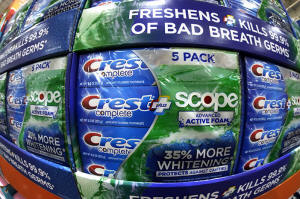A rare warning from Walmart during a US trade war: Higher prices are
inevitable
[May 16, 2025] By
ANNE D'INNOCENZIO
NEW YORK (AP) — Walmart, which became the nation's largest retailer by
making low prices a priority, has found itself in a place it's rarely
been: Warning customers that prices will rise for goods ranging from
bananas to car seats.
Executives at the $750 billion company told industry analysts Thursday
that they're doing everything in their power to absorb the higher costs
from tariffs ordered by President Donald Trump.
Given the magnitude of the duties, however, the highest since the 1930s,
higher prices are unavoidable, and they will hurt Walmart customers
already buffeted by inflation over the past three years.
Trump’s threatened 145% import taxes on Chinese goods were reduced to
30% in a deal announced Monday, with some of the higher tariffs on pause
for 90 days.
Those higher prices began to appear on Walmart shelves in late April and
accelerated this month, Walmart executives said Thursday. However, a
larger sting will start to be felt in June and July when the
back-to-school shopping season goes into high gear.
“We're wired to keep prices low, but there’s a limit to what we can
bear, or any retailer for that matter,” Chief Financial Officer John
David Rainey told The Associated Press on Thursday after the company
reported strong first-quarter sales.
Rainey emphasized that prices are rising not just for discretionary
items such as patio furniture and trendy fashions, but for basic
necessities as well. The price of bananas, imported from Costa Rica,
rose from 50 cents per pound, to 54 cents. He thinks car seats made in
China that currently sell for $350 at Walmart will likely cost customers
another $100. Baby strollers are also sourced from China, Rainey said.

Higher prices arrive as many Americans pull back on spending as they
grow increasingly uneasy about the economy. A slew of companies
including toy manufacturer Mattel, toolmaker Stanley Black & Decker and
consumer products giant Procter & Gamble have announced higher prices or
plans to raise prices.
But Walmart's moves are even more significant given its outsized power
in the retailing landscape. Walmart says that 90% of American households
rely on the retailer for a range of products, and more than 150 million
customers shop on its website or in its stores every week. Analysts will
dissect the earnings reports from other retailers including Target and
Home Depot, set to be released next week.
Government data Thursday revealed slowing sales growth for retailers.
Walmart says that its consumers have become cautious and selective.
Tariffs on China and other countries are threatening the low-price model
at the core of Walmart’s success.
The full impact of tariff costs had been delayed as companies tried to
beat the clock by bringing in foreign goods before Trump’s tariffs took
effect. Retailers and importers had also largely halted shipments of
shoes, clothes, toys, and other items due to new tariffs, but many are
resuming imports from China in the narrow window that opened during the
temporary “truce” this week, hoping to avoid sparse shelves this fall.
Yet retailers, already operating on thin margins, say they have no
choice but to raise prices to offset higher costs from tariffs. And they
are also bracing for higher shipping costs fueled by a surge of
companies scrambling to get their goods on ships to the U.S.

[to top of second column] |

This is a display of Procter and Gamble Crest toothpaste in a Costco
Warehouse in Pittsburgh on Thursday, Jan. 26, 2023. (AP Photo/Gene
J. Puskar, File)
 Rainey told The Associated Press
that the retailer did not pause shipments from China as a result of
the tariffs like others because it didn't want to hurt its suppliers
and wanted to keep merchandise flowing. It has built in hedges
against some tariff threats. Two-thirds of Walmart’s merchandise is
sourced in the U.S., with groceries now accounting for roughly 60%
of Walmart’s U.S. business.
Still, Walmart isn’t immune.
CEO Doug McMillon told analysts Thursday that Walmart imports
general merchandise from dozens of countries. But China, in
particular, represents a big chunk of volume in certain categories
like electronics and toys.
Tariffs on countries like Costa Rica, Peru and Colombia are raising
costs on groceries like avocados, coffee and roses, in addition to
bananas, company executives said. In some cases, Walmart is
absorbing costs on general merchandise within departments or a
category and not simply passing on a tariff cost attributable to
each item individually, executives said.
Walmart is also asking suppliers to swap input materials for
components if possible, for example, using fiberglass instead of
aluminum, which Trump hit with tariffs in early March.
“We're very dependent upon imports for these types of products,”
Rainey told The Associated Press.
He said there are some goods for which Walmart simply can't shift
production or produce easily in the United States.
McMillon, who was among a select group of CEOs of major retailers
who met with Trump at the White House late last month to discuss
tariffs, told analysts Thursday that he's hoping tariffs would be
further reduced.
Walmart earned $4.45 billion, or 56 cents per share, in the quarter
ended April 30, down from $5.10 billion, or 63 cents per share, in
the same period last year.
Adjusted earnings per share were 61 cents, exceeding the 58 cent
projections from industry analysts, according to FactSet.

Revenue rose 2.5% to $165.61 billion, just short of analyst
estimates.
Walmart’s U.S. comparable sales — those from established physical
stores and online channels — rose 4.5% in the second quarter, though
that’s slowed from a 4.6% bump in the previous quarter, and a 5.3%
increase in the third quarter of 2024. .
Business was fueled by health and wellness items as well as
groceries. Sales were weaker in home and sporting good, which was
offset by robust sales of toys, automotive goods and kid’s clothing,
the company said.
Global e-commerce sales rose 22%.
Walmart said it expects sales growth of 3.5% to 4.5% in the second
quarter.
Like many other U.S. companies, however, it did not issue a profit
outlook for the quarter because of the chaotic environment, with
stated U.S. tariff policies changing constantly. The company
maintained its full-year guidance issued in February.
All contents © copyright 2025 Associated Press. All rights reserved |